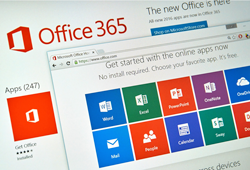Migrating to Office 365? Avoid These 10 Common Pitfalls

Organizations large and small are making the move to Microsoft Office 365, and for good reason. Office 365 makes it easier for employees to effectively work, communicate and collaborate in the cloud. Additionally, O365 reduces the costs associated with maintaining network and server upgrades and configurations.
While Office 365 offers many benefits, organizations can run into a number of issues if the migration project is not planned and implemented correctly. At Acropolis, we’ve successfully completed tons of O365 migrations and have learned some important lessons along the way.
Here are some of the most common pitfalls to avoid, and how to solve them.
-
Develop a Clear Plan. Like any IT project, it’s important to have a project plan before migrating to Microsoft Office 365. Without one, you may bring your organization’s work to a halt or lose important data. A clear plan, including an employee communication plan, will keep your entire organization humming.
-
Choose Your Package. There are multiple Microsoft Office 365 packages to choose from. Talk to your employees before choosing a package: what do they need or want that they don’t have now? How can an updated Office solution help them accomplish their goals, boost productivity and streamline workflow? Picking the right O365 package will help in the long run.
-
Upgrade if Necessary. If your organization is still running Microsoft XP, Windows 7 or even Windows 8 or using exchange 2007 servers, you’ll run into issues with Office 365. O365 works best with modern computers running Windows 10, so prepare to upgrade your onsite computers (and other infrastructure if applicable).
-
Address Internet Bandwidth. As a cloud-based solution, Office 365 relies on a high-speed internet connection with robust bandwidth. Organizations with low bandwidth and a slow connection will be at a disadvantage after the migration, so properly test your connection and make any necessary adjustments or upgrades, is key.
-
Helios Solutions. Although O365 is typically referred to as a single platform, it can be configured in a number of ways depending on your needs. You can opt for our Helios Cloud to keep some pieces of the environment either onsite or in a private cloud. A Helios Cloud solution makes sense for many organizations with unique requirements such as compliance, archiving, and/or security requirements, as well as organizations with on-premise, legacy, line of business applications.
-
Don’t Forget Third Party Tools: Although Office 365 is a robust software suite, many organizations still utilize additional third-party tools or additional office add-ons, ranging from Microsoft Project Pro to spam filters and line of business applications. Failing to account for these tools, and the additional time it will take to configure them, is one of the most common O365 migration issues. Likewise, if you have voice to email set up, starting the migration process without a proper plan to address this tool can break your voicemail to email functionality.
-
Mailboxes and files are too big. While the business versions of Office 365 come with 100 GB of email storage and over 1 TB of file storage per user, getting your emails and files online could take a while, especially if you have users whose inboxes are approaching the storage limit. As a general rule of thumb, larger files will cause the migration of files to take longer. If you don’t prepare for this, then you could see migration affecting work or even causing recurring issues of unavailable data when it’s needed. To avoid this, encourage your staff to archive their email inboxes and either delete or remove emails with large attachments that aren’t necessary.
-
Pilot Testing. Before rolling Office 365 out to your whole organization, perform a pilot group install. This will help you identify organization-specific “gotchas”. Additionally, since mobile device and tablet reconfiguration is needed, you can put processes in place during the pilot migration to help employees after the full roll out.
-
User Training. While getting O365 up and running is the most difficult part of a migration, failing to properly train employees, especially on major changes in daily functionality, can hinder any organization. Proper training will keep business running smoothly, while providing opportunities for employees to learn about new tools such as Microsoft Teams and OneNote to improve their productivity.
-
DIY migrations. On paper, migrating to Office 365 is a fairly simple and straightforward process. What many companies find when they do the migration themselves is that the process is much more difficult than expected. They come across unexpected issues that require an Office 365 expert to solve. In order to ensure a smooth migration, it’s a good idea to work with an IT provider like Acropolis Technology Group.
Although migrating to Office 365 seems like a straight-forward process, working with a Gold Certified Microsoft Partner like Acropolis Technology Group will help prevent data loss, control costs and avoid common roadblocks and ultimately ensure a smooth transition. Contact us today to speak with our Cloud migration experts and learn about our Office 365 Support Services.
